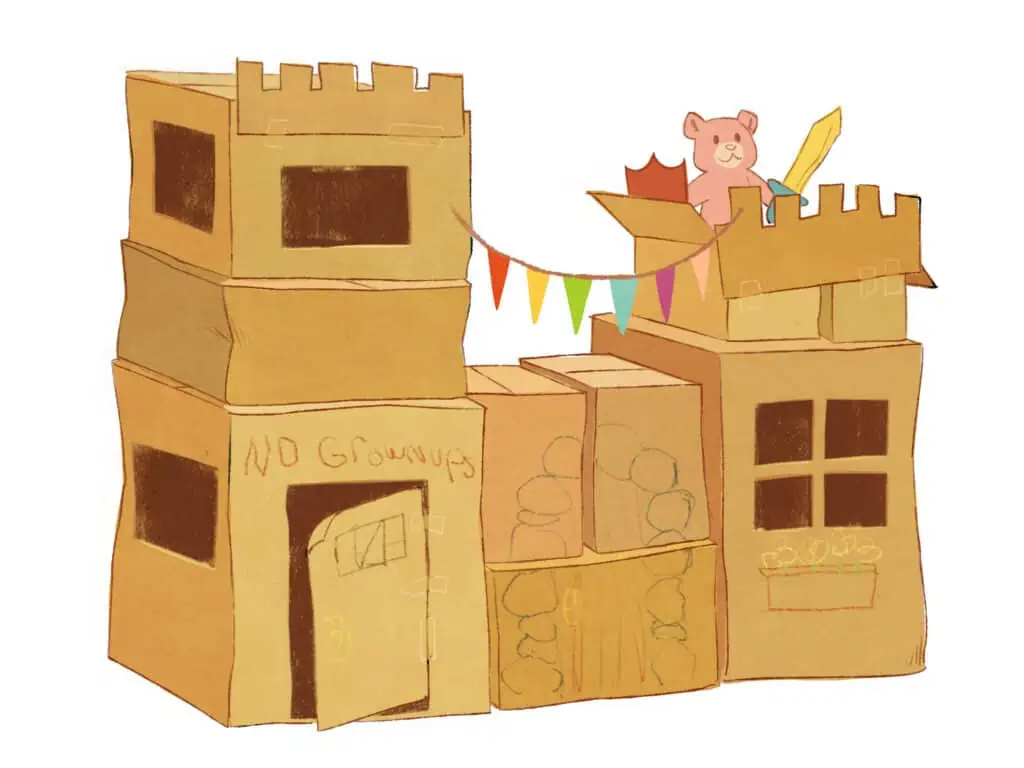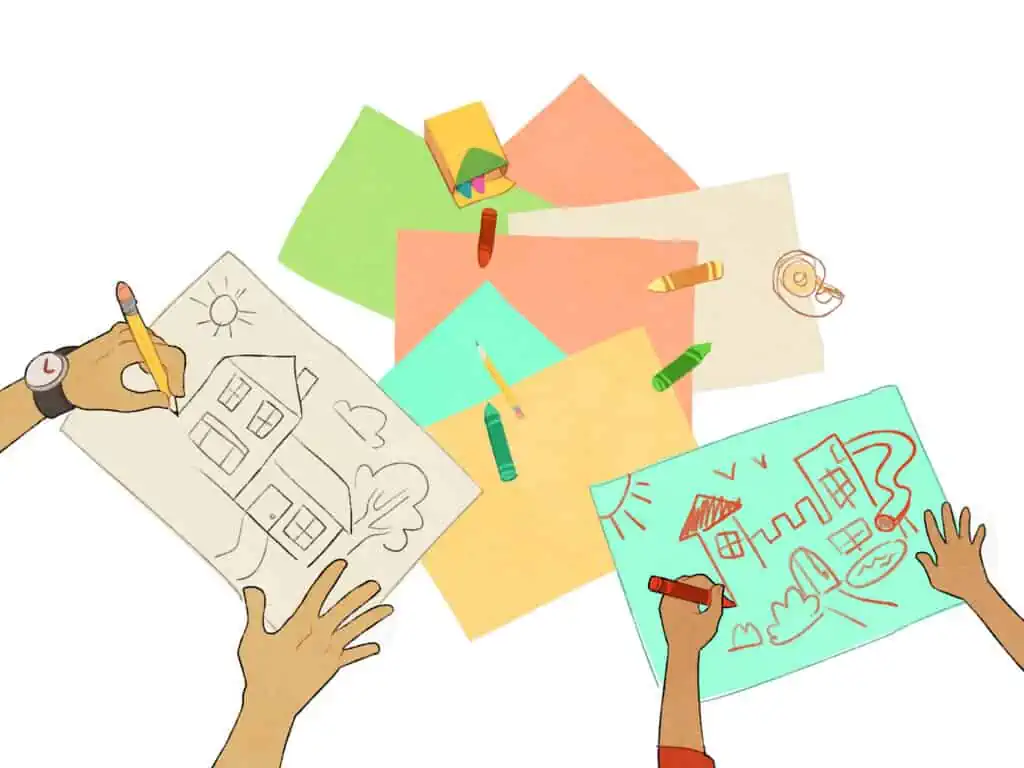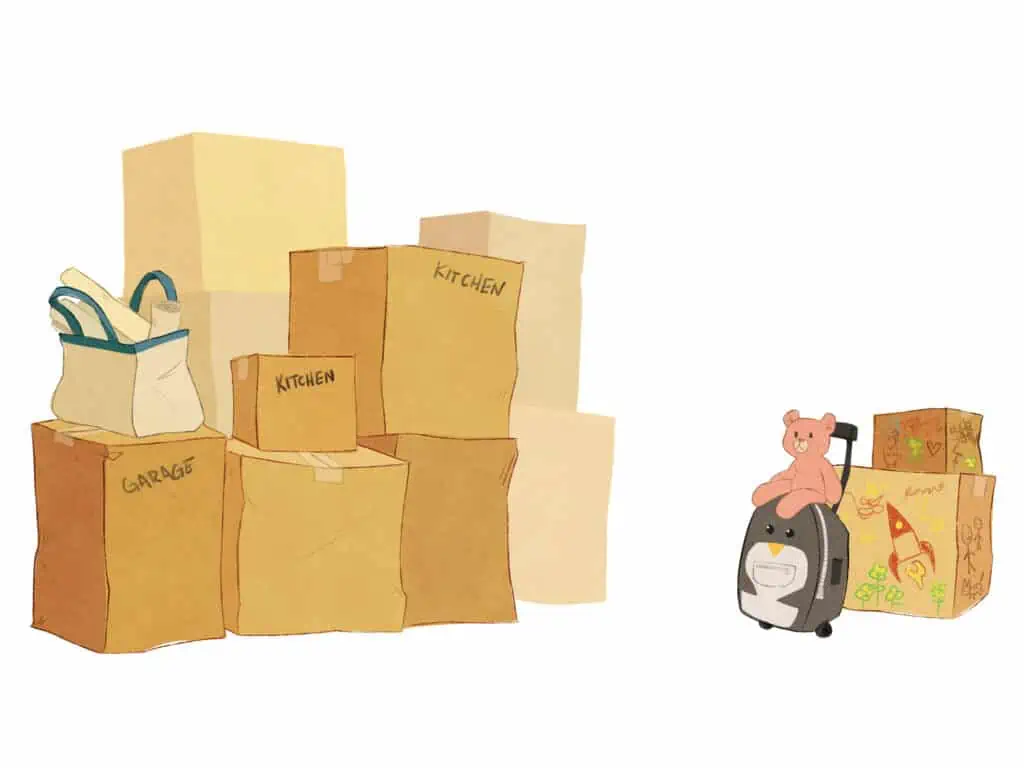Moving for adults is a generally stressful and draining event, but relocating with your child comes with even more physical and emotional needs. While we adults can tell ourselves, “just deal with it,” and have plenty of coping skills for demanding situations, that won’t work for a young child.
Before, during, and after your move, your child will need lots of help learning how to handle the move. After all, their lives are being completely upended. In this guide, we’ll show you 7 key strategies to help you prepare your child for a move, plan a successful moving day, and help your little one settle into their new home.
1. Preparing Your Child Emotionally
Kids can have big emotional reactions to a move. It makes sense — they’re leaving everything that feels familiar, and often due to reasons they had no choice in (like a new job) or other big life events (like a divorce). Make the process easier on your child by helping them navigate these uncomfortable emotions.
Speak Positively About the Move
Children are experts at taking emotional cues. When you look or sound sad, it can trigger a lot of stress in them as well. At the same time, over-the-top enthusiasm can also be confusing for your child. They’re sure to experience some negative emotions, so it’s not helpful to act as if these feelings don’t or shouldn’t exist.
The solution? Acknowledge the downsides, but emphasize — early and often — the positive things you can all look forward to. Maybe they get to have their own room now, or they’re moving closer to an exciting landmark like the ocean, or there’s enough space in the new home to get pets.
Show Kids Pictures of the New House
Once you find a place, get your kids excited about the move by showing them photos and videos. Point out their new bedrooms, and show off perks like a big backyard or a cool family room. While you’re at it, look at photos of nearby places such as parks, playgrounds, and pizza parlors. You could also watch a few YouTube videos about the neighborhood and make plans to go out and explore before the move.
Read Children’s Books About Moving
Books can help younger children understand all their complicated feelings about the move. Here are three good ones to try:
Discuss the books with your kids, and encourage them to ask questions. Openly talking about their feelings can make the emotions feel less scary.
Mark a Calendar With the Move Date
Count off each day as it passes. Not with big black X’s — those are no fun and pretty ominous. Instead, let your child put a sticker on each square. Give them extra stickers for the days they help with moving tasks or navigate tough emotions.
2. Preparing Your Child Physically
Moving means that your child has to leave everything that’s familiar to them. This is a huge transition, especially for little ones. Use these tips to help them ease into a new home.
Dream Up New Uses for Moving Boxes

For kids, the boxes are the best part of moving. As you pack, come up with creative ways to use the boxes once you unpack. They might want to build a fort out of big boxes or turn little boxes into dollhouses. Let them mark each box they want to use with a “secret symbol” to remind them of the exciting possibilities.
Give Your Child a Special “Treasure Chest”
Make a treasure chest out of a cardboard box, and let your child fill the box with their most prized possessions. There are no rules — as long as it fits in the box, it can come. Let them draw all over it (and the rest of their boxes, too).
“[Asking the movers to load your child’s room last] gives your child as much time as possible in their private space. It also means their things will be coming off the truck first at your new home.”
Your child might not even open that chest during the trip, but that’s okay. Just knowing all their most prized possessions are still with them — or somewhere in the back of the car — may be enough to help them feel secure.
Of course, they’ll still want something to do during the hours or days until the movers show up with all of your belongings. Make sure you fill a backpack with books, paper and crayons, small toys, and other items that might be fun to have on hand.
Hire a Babysitter While You Pack
It is probably easier for everyone to get your kids out of the house while you pack. You can send them off to grandma’s for the afternoon, or schedule playdates with their friends, or hire a babysitter to take them to the zoo or a movie.
Fun activities take kids’ minds off the move, giving them a break from their emotions and the chaos of their schedules being disrupted. It also takes them off your hands, so you can get things done.
3. Managing Moving Day
The action on moving day can be a lot for your child. To protect them from the overwhelming activity and emotion, be prepared with a few kid-friendly solutions.
Assign a Kids-Only Room

Choose one room that’s just for your kids on moving day, and stock it with toys, portable game systems, art supplies, or an iPad loaded with TV shows. Their bedroom is a good choice, as it’s where they’ll feel most secure. However, your kids probably won’t want to be cooped up in one room all day, so you should plan for other activities. For example, you could ask a family friend to play with them outside or walk to a nearby park.
Think about getting something new for them to have with them in their private space. Something as simple and compact as a Nerf basketball hoop, a stuffed animal, or a new movie can help keep them happy and busy. Then, they can take it with them to their new home.
Give Kids a Job on Moving Day
When your kids get restless, give them a job. You can ask them to open the door to each bedroom, bathroom, and closet when it’s time to show the movers around. They can also care for the movers by passing out bottles of water or paper plates for the pizza.
Younger children might need a task that feels more like playing. Spark their imaginations by explaining that the upstairs hallway and the pathways to the front door are the movers’ runways, and tell them they can help by keeping the runways clear.
Keep Their Tummies Happy
By moving day, your fridge will probably be empty and defrosted. Instead, stock a box and a cooler with food and drinks for moving day and the trip to your new home. Hit the supermarket for low-prep food items — cereal, yogurt and fruit, sandwiches and veggies, and, of course, sweet treats! Then, get something special for dinner, like pizza delivery or a Happy Meal.
While paper plates and cups are super-convenient when you’re on the road, they aren’t exactly comforting. Consider bringing your child’s favorite cereal bowl, dinner plate, or cup in the car to add a sense of comfort and continuity.
Ask the Movers to Load Your Child’s Room Last
This strategy gives your child as much time as possible in their private space. It also means their things will be coming off the truck first at your new home. It’s a small step that can make your kids feel happy and important as you make the big transition.
4. Traveling With Children
Just as your kids adjust to an empty house and a moving truck full of stuff, they need to tackle another challenge — traveling to their new house. Whether you’re moving across the world or down the street, you can help your child manage by making the journey comfortable, with a touch of fun along the way.
Car Travel Tips

Instead of looking at the car trip like it’s a necessity, turn it into a memorable part of the move. Staying overnight? Book a hotel with a pool, and spend a couple of hours splashing around as a family. Or, stop at an interesting roadside attraction.
Keep in mind that road trips with kids always take longer than you expect and need more stops. Prepare by stocking the car with tasty snacks and essential supplies like wet wipes or extra diapers. You can even buy a new book or a car game to break out during the last few hours.
Air Travel Tips
With missed naps and kids running off energy in the airport, flying with kids can feel like a minefield. If possible, schedule flights to coincide with naptime. Your kids will fall asleep, and you can relax. Or, choose a plane with in-flight entertainment, and let the movie distract them.
Moving Day Survival Kit
Whether you’re traveling by car or plane, a bag of special treats can make all the difference in keeping your child calm and content. Load it with new candies, toys, games, and snacks. For older kids, toss in a book or a video game they’ve been wanting to try.
Here’s the secret — don’t show your child everything at once! Pull out a new item to reward calm behavior or to head off a tantrum.
5. Acclimate Them to Their New Home, Right From the Start
For adults, settling into a new home is already a big challenge. When you involve a child, the experience takes on a whole new level of difficulty and importance. Don’t be surprised if they melt down or act unusually emotional — they’re processing a huge emotional shift and need steady reassurance, patience, and comfort to feel secure.
Make an Event of Seeing Your Stuff Again
Welcome the movers, and celebrate as you pull out familiar items. There’s nothing like a favorite comforter or a box of toys to make a new house feel like home.
You can also get your child involved in the organization process. Ask them where they think the TV should go, help them arrange their bedroom, and talk about how they can decorate it. Work with them to imagine all the fun things you’ll be able to do in the family room, the basement, and the yard.
Put Off Unpacking Until You Tour the Neighborhood
Even if the unopened boxes are calling your name, take some time instead to help your child get accustomed to their new surroundings. Go for a walk together, say hello to your new neighbors, and check out the closest park.
At the end of the day, make sure they feel safe and secure in their new room. The rest of the house may still be a sea of cardboard and shrink-wrapped furniture, but your priority should be making your child feel at home.
6. Tips for Special Age Groups
Your kids’ ages can affect how they deal with moving. A teenager will have much different struggles than a toddler. Here’s how to create a better experience when moving with kids in different age groups.
Babies and Toddlers
Kids up to age 3 are highly affected by your emotions and the changes to their schedules. Try to stick to the same sleep and feeding times, even when you’re in the home stretch of packing. Keep a beloved blanket or stuffed animal on hand to make a strange place feel more familiar.
Preschoolers and Young Children
Kids this age love structure, so you might find that they’re more moody or irritable when you’re moving. They might have trouble sleeping, or you might notice some unusual behaviors. As with babies, it’s helpful to keep your child on schedule. Start creating new routines as soon as you move in, and involve them in unpacking and setting up their rooms.
School-Aged Children
At this age, the thought of being the new kid at school and finding new friends can bring your child (and you) on an emotional rollercoaster.
“Don’t be surprised if [your child melts] down or [acts] unusually emotional — they’re processing a huge emotional shift and need steady reassurance, patience, and comfort to feel secure.”
You can help by validating their emotions — let them know it’s normal and okay to feel scared or worried. Remind them that they’re an awesome and interesting kid, and tell them that the new school and neighborhood will be filled with lots of new friends. Signing them up for new activities can help them settle in — and make friends — faster.
Teenagers
Of all the age groups, moving is most difficult for teenagers. Leaving their social groups and activities can be heartbreaking, especially if it means they can’t graduate with their friends. Ease their anxieties by communicating about what to expect during the move. Make sure they know you’re there to let them vent and talk through their worries.
7. Handling Emotions and Challenges
There’s no getting around it: moving with kids is hard. As they say on airplanes, you should help yourself first. Prevent your emotions from affecting your kids by finding strategies for managing the stress of moving, whether that’s working out or meditating.
Once you’ve got yourself settled, you can help your kids deal with common challenges such as emotional stress, interrupted routines, adjusting socially, and educational changes.
Here are some tips to help your kids handle the emotions and challenges of a move:
- Encourage communication and open expression: Giving your child a safe space to cry, rage, and yell can help them work through hard emotions and prevent meltdowns.
- Release stress: Hitting balls at the driving range, jumping at a trampoline park, or running around in the park can release tension.
- Celebrate your community: Give your kids time to hang out with friends and family before the move, and think about hosting a going-away party.
- Stay in touch: Use FaceTime to help your child stay in touch with loved ones and deal with separation anxiety.
- Involve your kids: Let your child participate in the move to help them feel in control. You could give them input on your new house or let them pick out a bed for their new room.
Finally, and most importantly, remember the first point: kids take their emotional cues from you. Your positive attitude will help your child feel calmer, even when the move feels hectic and challenging. And that works for adults, too.
Moving With Children Checklist
Things can get lost in the chaos. That’s why a checklist is important to keep everything top-of-mind, even when a lot of your focus is going to taking care of your kids. Use this downloadable PDF to keep things on track for you and your family:

